The 1970s: When Romance Got Messy, Sexy, and Mass-Market
Pirates, paperbacks, and the decade that flipped the genre on its head
The 1970s: When Romance Got Messy, Sexy, and Mass-Market
What if you could trace the evolution of the romance genre, one era at a time?
You’d meet heroines in corsets and secretaries on lunch break, Greek billionaires with brooding eyes, and a publishing industry in a full-blown transformation. The genre has never stood still—and neither have its readers.
Welcome to Once Upon a Genre: Romance Over the Decades—a series exploring how romance fiction has evolved across generations, trends, and societal shifts. From cultural clashes to cover scandals, from steamy tropes to literary backlash, we’re diving deep into the stories that shaped the stories.
We’re starting with the 1970s: the era when romance stopped playing nice.
This post contains affiliate links. That means we receive a small commission at no cost to you from any purchases you make through these links.
The Birth of Modern Romance
The 1970s didn’t just shake up romance novels—it rewrote the rules. Second-wave feminism, the aftermath of the sexual revolution, and a market suddenly wide open for stories by women, for women.
Out went the chaste kisses and dutiful heroines of mid-century paperbacks. In came epic historicals, morally murky heroes, and stories unafraid to explore physical desire. Romance became bolder—and much harder to ignore.
What Were Readers Actually Reading?
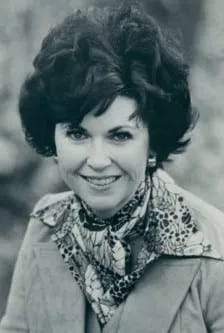
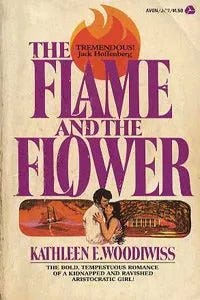
In 1972, Kathleen E. Woodiwiss changed everything with The Flame and the Flower. It wasn’t the first historical romance—but it was the first to go mainstream with sensuality, drama, and emotional highs that hit like a freight train.
Heroines like Heather Simmons weren’t purely empowered, but they weren’t passive either. They endured kidnappings, forced marriages, and dangerous men—but they also made choices, survived, and often came out stronger on the other side.
Meanwhile, Harlequin, having acquired Mills & Boon in 1971, was on its own tear. They began flooding North American drugstores and grocery aisles with slim category romances—bite-sized stories featuring secretaries, nurses, and teachers finding love with grumpy bosses and moody doctors.
By the end of the decade, Harlequin was selling 100+ million books a year and owned 80% of the North American romance market.
The Rise of Sensuality
The 1970s opened the door for steamy, emotionally intense storytelling.
Authors like Rosemary Rogers (Sweet Savage Love) gave readers stormy, sensual sagas where heroines weren’t punished for wanting pleasure. And while critics loved to slap the “trashy” label on them, readers devoured every page.
Even Kathleen E. Woodiwiss pushed back on the idea that these stories were just about titillation:
“People used to call my books erotic,” she told the New York Times in 1977.
“I used to say, ‘No, they’re not erotic. They’re sensuous. They’re written to excite the emotions, not the body.’”
That distinction helped shape how the genre approached intimacy—less shock value, more emotional weight.
Subgenres That Took Shape
The ’70s gave rise to three major romance pillars:
Historical Romance
From medieval moors to the high seas, these were epic, sweeping, and emotionally intense. Think: The Wolf and the Dove and Ashes in the Wind
Category Romance
Harlequin’s formula worked: short, emotionally satisfying stories in modern settings, featuring “everyday” women with dreamy (if sometimes controlling) love interests.
Gothic Holdouts
Though fading fast, gothic romance hung on with heroines exploring haunted houses and unearthing dark family secrets. Victoria Holt’s The Pride of the Peacock was a standout.
I feel strongly that the women who were first writing, like Kathleen Woodiwiss and Rosemary Rogers — it was a tremendous breakthrough, what they did. The explicit sexuality in the books allowed women to express their own sexuality. And a heroine could have sex and not die at the end of the story. ~ Author Loretta Chase
Tropes, Character Types, and Settings of the 1970s
If there’s one word to sum up ’70s romance: extra. These books went big—big drama, big danger, big dresses on the cover. It was the era of alpha heroes with mysterious pasts, heroines who got kidnapped at least once, and love that conquered war, class divides, and probably a pirate attack or two. Whether set in medieval castles, Civil War–era mansions, or on the deck of a ship bound for revenge, these stories leaned into spectacle, stakes, and unapologetic emotional intensity.
And of course, the tropes delivered:
Popular Tropes
Marriage of convenience, usually under duress and with maximum angst
Kidnapping and captivity—and yes, this was often the meet-cute
Pirate abduction or high-seas revenge romance
Enemies to lovers, but with real swords involved
Amnesia, mistaken identity, and “wait, you’re actually nobility?”
Forbidden love across enemy lines, class divides, or wartime borders
Jealous rivals, scheming stepmothers, or evil exes as plot spice
Fated love with past-lives and war-torn separation
Character Types You Couldn’t Escape
The tortured alpha hero who solves everything with passion and brooding
The spirited heroine who absolutely does not want to marry him (until she does)
The roguish pirate, aristocrat, or sheikh with a dominant streak
The reluctant bride, usually strong-willed, always secretly soft-hearted
Side characters who exist to die dramatically or deliver game-changing information
Villains who twirl mustaches or manipulate inheritances from the shadows
Backdrop Settings
Medieval England or Scotland, complete with moats, manors, and marriage contracts
The American South, especially around the Civil War and Reconstruction
Revolutionary War–era America, with patriots, spies, and masked balls
Imperial Russia, the “exotic” East, or fictional sheikhdoms, often romanticized
Caribbean islands and open seas, perfect for pirate drama
Australian outposts with rugged landowners and sweeping estates
Mysterious mansions, often harboring secrets, curses, or hidden passageways
These settings weren’t just backdrops—they were plot devices, character motivators, and often reflections of the genre’s thirst for scale and spectacle.
In short: if you couldn’t ride a horse, faint dramatically, or get kidnapped by a pirate with a dark past, it probably wasn’t a 1970s romance.
Covers: Clinches and Maximum Fabric Drama
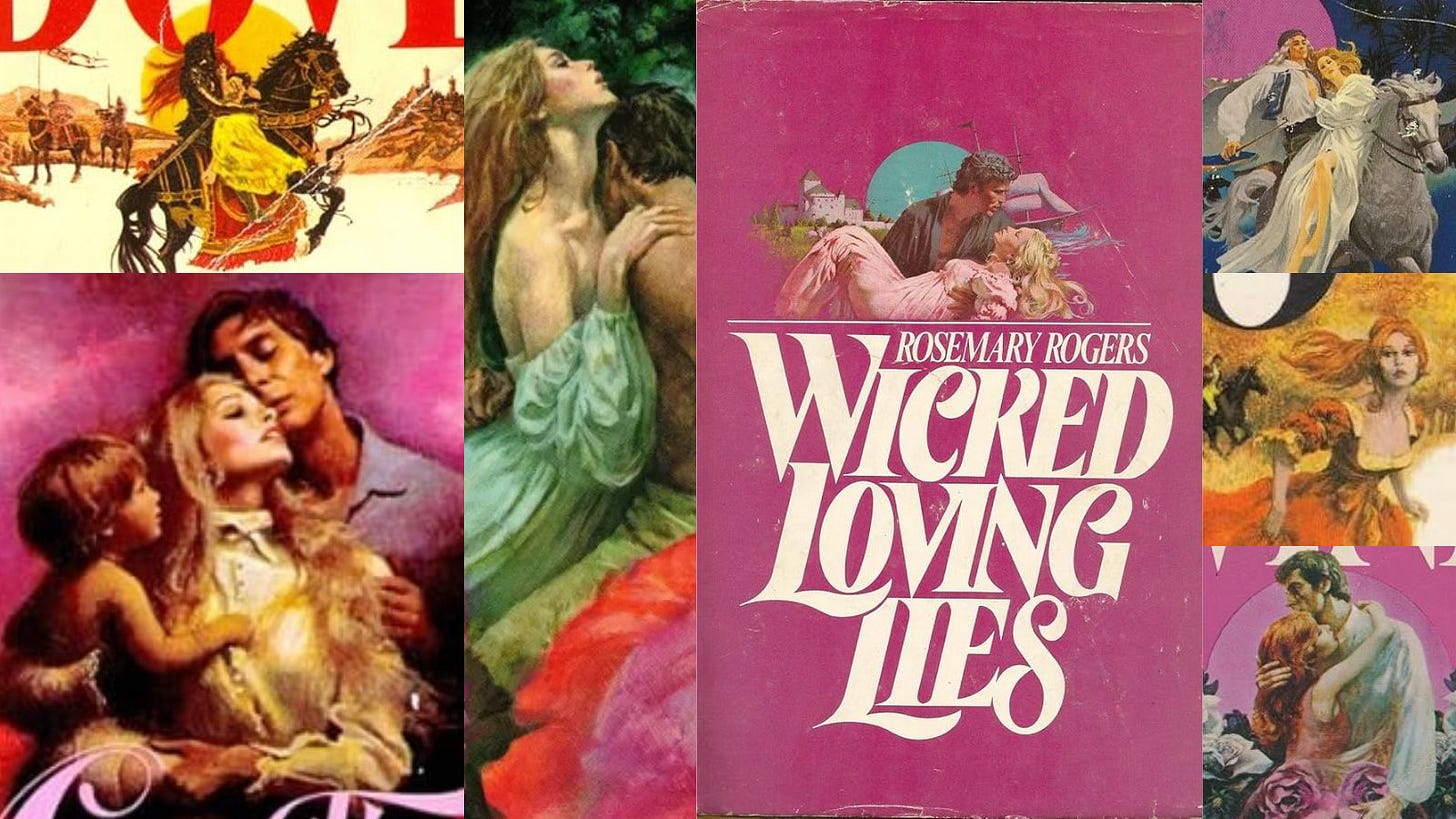
The early 1970s covers still echoed the tender clinch style of previous decades—more suggestive than steamy, with soft embraces and longing gazes. But as the decade progressed, romance began to come out of its visual shell, leaning into bolder poses, heightened sensuality, and a whole lot more chest.
By the mid-’70s, the romance cover had fully embraced what we now think of as the full-body clinch—a muscular hero gripping the heroine mid-swoon, her dress sliding off one shoulder, his shirt strategically open (or missing entirely), and at least one of them caught in a windstorm of velvet and longing.
These covers weren’t subtle—but they weren’t meant to be. They sold fantasy and feeling, fast. You knew the tone of the book just by the embrace on the front.
The bold marketing started here—with increasingly lush, emotionally charged images that pushed books from “genre” to cultural icon.
We’ll be doing a full post on the evolution of clinch covers (and stepbacks) later in this series—because those hidden inner scenes had their own era.
Exoticism, Erasure, and Who Got the HEA
While the 1970s expanded the genre’s reach, it often did so through a very narrow lens.
Most heroines were white, straight, and Western—usually British or American. And when other cultures appeared, they were often reduced to caricature or fantasy.
The “sheikh romance” became a go-to trope, along with Greek, Italian, and Latin heroes who were exoticized rather than humanized. These men were usually described as dangerous, hyper-masculine, and impossibly wealthy, living in settings that bore little resemblance to the real world.
Meanwhile, heroines of color were nearly invisible in traditional publishing. Stories by and about Black, Indigenous, Asian, and Latinx women weren’t just rare—they were mostly left out entirely.
It would take decades—and trailblazing authors like Beverly Jenkins and Sandra Kitt—to begin shifting that narrative.
A Note on Consent and the Darker Side of ’70s Romance
Not everything from this decade holds up.
Scenes with dubious consent or outright non-consensual encounters were unfortunately common, often framed as “overwhelming passion.” Heroes conquered heroines, and the genre blurred lines that readers today would (and should) challenge.
Still, these dynamics reflected the complicated push-pull of the time: feminist gains on one hand, lingering societal expectations of submission on the other.
Romance would evolve—but not without confronting these uncomfortable roots.
Cultural Impact: Romance Gets Political
The romance boom of the ’70s wasn’t just about sex or swoons—it was about power. These novels gave women permission to want more. Whether that meant pleasure, independence, or adventure, the genre became a quiet revolution in mass-market paperback form.
Authors like Janet Dailey, the first American published by Harlequin in 1974, brought working-class heroines and Americana settings into the fold, expanding what a love story could look like.
Romance became both commercial powerhouse and cultural lightning rod—one that literary critics often dismissed, but readers embraced wholeheartedly.
The HEA Becomes a Promise
Though the “Happily Ever After” wouldn’t be formally codified until RWA’s guidelines in the ’80s, the expectation was already clear by the end of the ’70s:
If a book put its heroine through 400 pages of trauma, there damn well better be a payoff.
The HEA became not just a trope—but a promise.
Time Capsule Authors of the 1970s
These were some of the women who defined the decade—not just in book sales, but in tone, structure, and emotional intensity. Some wrote sweeping historicals. Others delivered high-drama romances in 192 paperback pages. But all of them pushed the genre forward and laid the groundwork for everything from the billionaire trope to the HEA guarantee.
Kathleen E. Woodiwiss
The mother of modern historical romance, Woodiwiss changed everything with The Flame and the Flower (1972). It was the first mass-market romance to combine historical scope with explicit sensuality and deeply emotional storytelling. Heroines like Heather Simmons were battered, bold, and unforgettable.
→ Also try: The Wolf and the Dove (1974), Ashes in the Wind (1979)

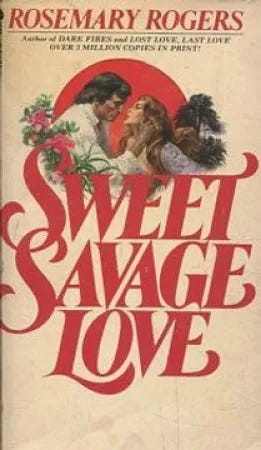
Rosemary Rogers
If Woodiwiss brought the sensuality, Rogers brought the chaos. Sweet Savage Love (1974) is infamous for its whirlwind plot, morally gray characters, and globe-trotting stakes. Her books were devoured, debated, and impossible to ignore.
→ Also try: Wicked Loving Lies (1976)
Johanna Lindsey
Lindsey’s debut Captive Bride (1977) launched a career that would span decades. With lush historical settings, alpha heroes, and rebellious heroines, she became one of the genre’s biggest names—and a major force in the 1980s and beyond.
Laurie McBain
With Devil’s Desire (1975), McBain captivated readers with her richly detailed settings, sweeping emotional arcs and characters. She helped cement the popularity of lush historicals with drama that read like cinematic epics.
Charlotte Lamb
A prolific writer for Mills & Boon, Lamb’s late-’70s titles—like The Long Surrender (1978)—began to push the emotional and sexual boundaries of the genre. Her heroines were often emotionally complex, and her stories tackled taboo themes with nuance that was ahead of its time.
Victoria Holt
The queen of gothic romance, Holt’s heroines wandered moody mansions, unearthed dark secrets, and survived dangerous love. The Pride of the Peacock (1976) stands out for its blend of mystery, opals, and emotional restraint.
Cynthia Wright
Wright’s Caroline (1977) brought a refreshing energy to Revolutionary War romance. Heroines were clever, resourceful, and unafraid to call their brooding heroes out. Historical accuracy and genuine chemistry made her a fan favorite.
Jude Deveraux
Deveraux’s early works like The Enchanted Land (1978) featured independent heroines, western backdrops, and plenty of slow-burn tension. She was part of the newer generation that helped romance explore American and frontier settings with emotional intensity.
LaVyrle Spencer
Known for quieter, emotionally layered romances, Spencer’s The Fulfillment (1979) focused on small-town life, real stakes, and gentle-but-firm love stories. Her books felt modern even as they worked within traditional structures.
Barbara Cartland
Publishing 20+ books a year, Cartland was the empress of ultra-traditional, chaste romance. Her heroines were pure and her heroes noble. While her work was out of step with the bodice-ripper trend, she remained one of the best-selling authors of the decade—period.
Mills & Boon + Harlequin Presents Pioneers
While Woodiwiss and Rogers ruled the bookstore shelves, category romance was quietly taking over drugstores and supermarkets—thanks to Mills & Boon and Harlequin Presents.
Notable names from this era include:
Violet Winspear, known for her intense alpha heroes and lush settings. One of the original Harlequin Presents authors when the line launched in 1973.
Anne Hampson, who wrote more than 100 novels and helped define the “sheikh” and “billionaire” fantasy long before they were tropes.
Janet Dailey, the first American published by Mills & Boon, whose Americana series brought a fresh, down-home voice to the line.
These authors didn’t just write bestsellers—they shaped the genre’s DNA. Whether you love them or cringe at them, their stories changed what romance could be—and what readers could ask for.
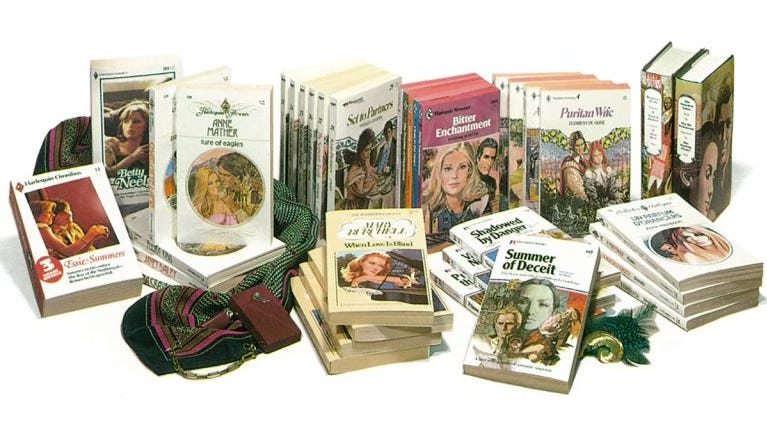
The Business of Love: Romance Publishing in the 1970s
So how did romance take over bookstores, drugstores, and basically every mom’s nightstand in the ’70s?
It wasn’t just the stories that changed—it was how they were sold.
The 1970s saw a seismic shift in the publishing industry. This was the decade where romance went mass-market, direct-to-reader, and full throttle on marketing—all without a single Instagram ad.
Let’s talk about the publishing heavy hitters and the behind-the-scenes mechanics that made romance a billion-dollar business.
The Rise of Mass-Market Paperbacks
Before the ’70s, most books came out in hardcover first. Expensive, heavy, formal. Then along came Avon Books, who made a game-changing bet: publish Kathleen E. Woodiwiss’s The Flame and the Flower (1972) as a paperback original.
It worked. Readers devoured it. Publishers took note. And suddenly, romance was on every grocery store spinner rack.
Mass-market paperbacks made romance accessible, affordable, and impulse-buy ready. These were books you could grab with your milk and pantyhose.
How Publishers Reached Readers
With no social media or book influencers to spread the word, publishers had to get creative.
Subscription models like the Harlequin Reader Service delivered monthly romance drops straight to your mailbox. It was a swoony Book of the Month Club.
Branding by line became key. Readers knew what to expect when they picked up a Harlequin Presents vs. Silhouette Romance. Emotional tone, heat level, even hero archetypes—it was all curated.
Free samples were handed out at department stores or tucked into mailers. Hook them with one, and they’d come back for ten.
Spinners and endcaps in non-bookstores (drugstores, grocery stores, etc.) put romance in front of people who didn’t browse bookstores. Accessibility was everything.
This was marketing before metadata—and it worked.
The Big Players (and When They Showed Up)
Harlequin Enterprises (founded in 1949, acquired Mills & Boon in 1971): They built the category romance empire and pioneered the subscription model that defined the decade.
Mills & Boon (founded in 1908, UK): Continued publishing through the ’70s with authors like Charlotte Lamb, Violet Winspear, and Anne Hampson—but under Harlequin’s North American arm.
Avon Books (founded in the 1940s, romance breakthrough in 1972): Took the risk on longer, steamier historicals with Woodiwiss, Rogers, and McBain. Basically invented the “bodice ripper.”
I joined Dell in 1978 as an associate editor. Dell had done romances before, but they did maybe one or two every couple months. It was considered the bottom of the barrel. My budget for books was between $1,500 and $3,000, and I had to buy so many — so I had to find writers. One day, [my boss] came to me and said I had to go to the SouthWest Writers conference, where writers came from all over the country to meet publishers. I got there, and when it was my turn, I introduced myself and said what I did: that I bought romance novels. I told these women what the stories should be — that they were about 60,000 words and called category romances because they followed a pattern. It was like a recipe. ~ Editor, agent and mentor Vivian Stephens
Who Was Buying?
Women. Women were buying.
Most readers were working- or middle-class women who wanted stories that centered their emotions, desires, and struggles. These books weren’t “just escape”—they were also release, relief, and in many cases, quiet rebellion.
Publishers knew it. And instead of marketing to critics or bookstores, they went straight to the reader’s home. They knew the tropes that worked. They knew the packaging that sold.
They knew their audience. And they knew how to keep them coming back every month.
The result? Romance wasn’t just a trend—it became the lifeblood of the paperback market. Before romance was digital, it was everywhere. You just had to know where to look.
TL;DR: Why the 1970s Mattered
Romance got steamier, longer, and more emotionally intense
The modern historical romance was born
Harlequin became a publishing empire
Cultural representation was limited—and often harmful
Consent was a messy battleground
But the seeds of genre reinvention were planted—and romance would never be the same
Coming Next: Big Hair, Bigger Publishing Deals
Next week: the 1980s
The decade of Silhouette, superstar authors, and the golden era of category romance. You’ll want shoulder pads for this one.
👉 Want more? Subscribe to follow the series as we go decade by decade through romance history.
Let’s Chat
Have you read any of the ’70s classics? Do you have a favorite wild cover or messy historical you still think about?
Hit reply or drop a comment—I’d love to know what stuck with you.
Sharing our love for books as Under the Covers Book Blog since 2011, running the Romanceopoly yearly reading challenge since 2019 and hosting the Reading Under the Covers podcast since 2020. Launched Mysterylandia in 2025.
Sources, References & Fun Reads
This post draws from both original commentary and the amazing work of romance historians, bloggers, and genre obsessives. If you're curious to go deeper, here’s a few articles to check out:


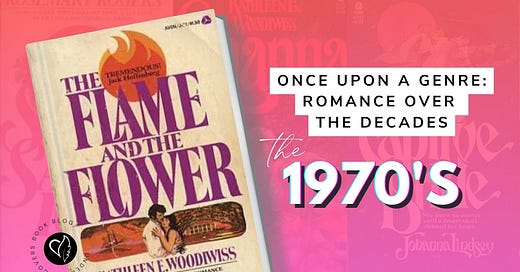




Fantastic! Can’t wait for the ‘80s and ‘90s
Oh, and loved this fab post!